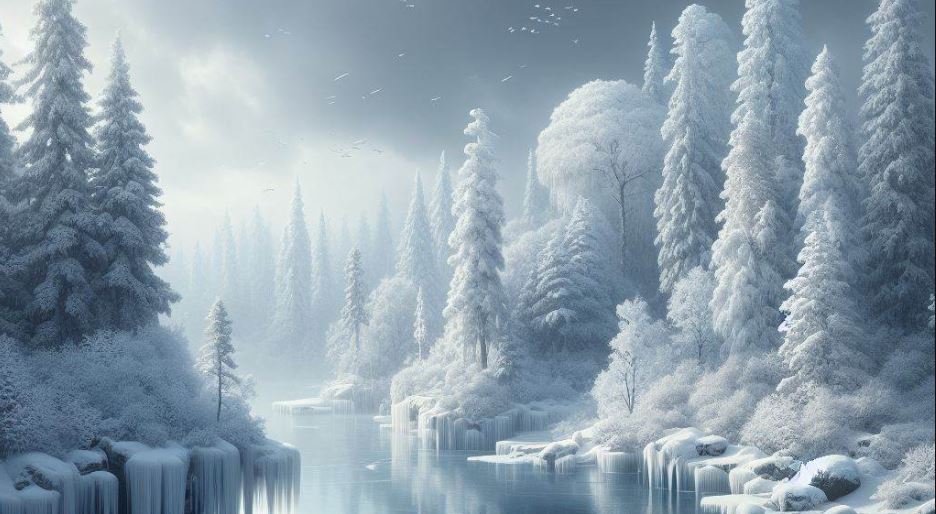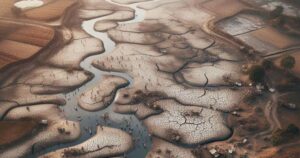Imagine a world perpetually cloaked in a blanket of snow. Sunrises bleed into an endless twilight, and the once vibrant symphony of nature is reduced to the mournful howl of the wind. This isn’t a scene from a dystopian novel; it’s a question that has captivated scientists and storytellers for centuries – what if the world was in a state of eternal winter?
The concept of an eternal winter, also known as a permanent ice age, throws a wrench into the delicate balance of our planet’s climate. While the thought might send shivers down your spine (pun intended!), understanding the potential causes and consequences of this scenario can shed light on the intricate workings of Earth’s systems and the fight against real-world climate change.
What Could Trigger an Eternal Winter?
There are several plausible culprits that could orchestrate an eternal winter. Let’s delve into a few of the most likely suspects:
- A Volcanic Apocalypse: Imagine a scenario where a series of supervolcanic eruptions spew gargantuan amounts of ash and sulfur dioxide into the stratosphere. These pollutants act like a giant sunshade, blocking sunlight and plummeting global temperatures. The Earth’s verdant landscapes would transform into a desolate, frozen wasteland, eerily similar to the volcanic winters experienced by the dinosaurs millions of years ago.
- The Wobbly Dance of the Planets: Our planet’s orbit and tilt aren’t perfectly fixed. Over vast timescales, these subtle variations can dramatically alter how sunlight is received by different regions. Imagine a situation where Earth’s tilt becomes so extreme that sunlight barely reaches the poles, plunging vast swathes of the planet into permanent darkness and frigid temperatures.
- A Cosmic Collision: While a Hollywood-style asteroid impact might be unlikely, a more subtle culprit could be a rogue asteroid or comet. The impact wouldn’t necessarily trigger an eternal winter, but the resulting dust cloud could block enough sunlight to significantly disrupt Earth’s climate system, potentially pushing us into an ice age.
How life on Earth might respond to such a drastic event?
The prospect of an eternal winter paints a bleak picture, but life, as we know it, has a remarkable capacity for adaptation. Let’s explore how life on Earth might respond to such a drastic shift:
- Survival of the Fittest: The first and most immediate consequence would be a mass extinction event. Species that rely on readily available food sources and temperate climates would struggle, while cold-adapted organisms like polar bears and penguins might find themselves thriving in the new normal. Imagine polar bear populations expanding their territory southward, while giant redwoods and lush rainforests become relics of a bygone era.
- Underground Havens: Imagine human societies retreating to the warmth of the Earth’s crust. Subterranean settlements powered by geothermal energy could become the new frontier, fostering a completely different way of life. Think of Jules Verne’s “Journey to the Center of the Earth,” but with a dash of climate science. These settlements would likely be highly communal, relying on advanced technology for everything from food production to waste management. Imagine vast hydroponic farms bathed in artificial sunlight, or intricate networks of tunnels connecting different geothermal hotspots.
- Technological Innovations: Necessity would undoubtedly be the mother of invention. New technologies like advanced hydroponics and algae farming could become crucial for sustaining life and producing food in the absence of sunlight-dependent agriculture. Imagine bioluminescent organisms being genetically modified to provide light for these underground communities, or sophisticated weather prediction systems that allow for the strategic use of geothermal vents for heating.
Can We Avoid an Eternal Winter?
The good news is that an eternal winter isn’t our preordained fate. Understanding the mechanisms that drive climate change allows us to take action. Here’s how we can prevent this icy nightmare from becoming a reality:
- Curbing Greenhouse Gas Emissions: The primary driver of our current climate change crisis is the unchecked emission of greenhouse gasses like carbon dioxide. Transitioning to renewable energy sources like solar, wind, and geothermal power is crucial in mitigating the effects of climate change and preventing a runaway greenhouse effect that could lead to an eternal winter. Imagine a world where sprawling solar farms dominate deserts, or wind turbines dotting skylines become a ubiquitous symbol of our commitment to a sustainable future.
- Global Cooperation: Climate change is a global issue, and solutions require a unified front. International collaboration on research, emission reduction policies, and technological advancements is essential to ensure a sustainable future for our planet. Imagine international treaties with real teeth, where countries hold each other accountable for their emissions reductions. Picture scientific communities across the globe sharing data and working
- Embracing Innovation: From solar panels to carbon capture technology, the solutions are out there – we just need to grab them with both mittened hands. By investing in green tech and thinking outside the igloo, we can turn the tide on climate change and keep winter at bay.
How our ingenuity and creativity might shine through?
- Art and Culture in the Cold: Imagine stories passed down through generations around flickering geothermal vents, tales of a bygone era with lush greenery and warm sunshine. Art forms might evolve to reflect the harsh beauty of the frozen world, with sculptures carved from ice and music that evokes the howling wind. Imagine bioluminescent organisms forming the basis for dazzling light shows, or intricate ice sculptures celebrating the resilience of life.
- The Power of Community: In a world where survival hinges on cooperation, the importance of community would be paramount. Imagine close-knit societies where everyone contributes to the collective good, sharing resources and knowledge to ensure the survival of the group. Elders might be revered for their wisdom and storytelling abilities, while younger generations learn the intricate skills needed to maintain the delicate balance of the underground settlements.
- A Connection to the Past: Humanity would likely not forget its origins. Imagine vast digital libraries preserving the memories of a warmer Earth, with virtual reality experiences allowing people to glimpse what life was once like. Archeological expeditions might delve into the frozen wastelands, uncovering remnants of the past and providing valuable insights into our history.
Would we Seek Refuge Amongst the Stars?
The concept of eternal winter also compels us to ponder the possibility of life beyond Earth. If our planet succumbed to an ice age, could humanity find refuge on another star?
- The Search for Habitable Planets: The ongoing search for exoplanets, planets outside our solar system, takes on a new urgency in the face of an eternal winter. Imagine a renewed focus on space exploration, with powerful telescopes scanning the cosmos for Earth-like planets that could sustain human life. The discovery of a habitable world would offer a glimmer of hope for humanity’s future.
- The Challenges of Interstellar Travel: Reaching distant planets capable of supporting life presents a monumental technological hurdle. Imagine advancements in propulsion systems that allow for interstellar travel, or the development of suspended animation technology to enable journeys spanning generations. The prospect of colonizing another world would require international cooperation on a scale never before witnessed.
While an eternal winter might seem like a fantastical scenario, the concept serves as a stark reminder of the delicate balance of our planet’s climate system. The ongoing fight against climate change isn’t just about preserving the beauty of our natural world; it’s about ensuring the very survival of humanity and the countless species we share this planet with.
By transitioning to renewable energy sources, reducing our carbon footprint, and fostering international cooperation, we can avert this icy apocalypse. The story of an eternal winter is a cautionary tale, but it’s also a call to action. Let’s ensure that future generations inherit a world bathed in sunshine, not shrouded in perpetual winter.






